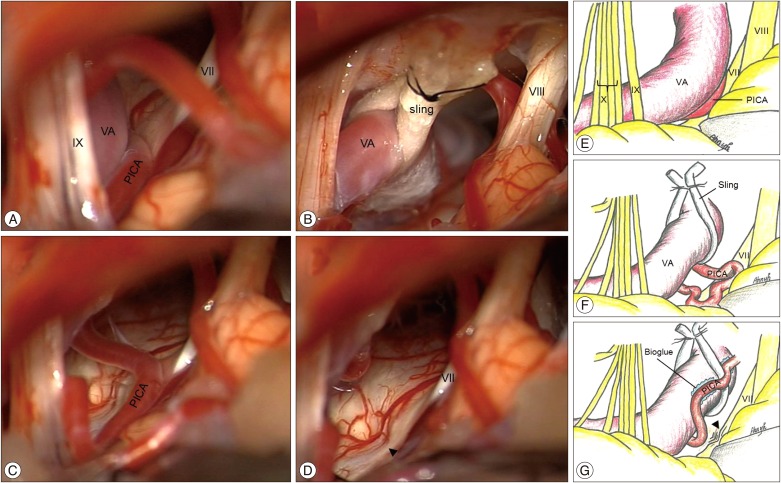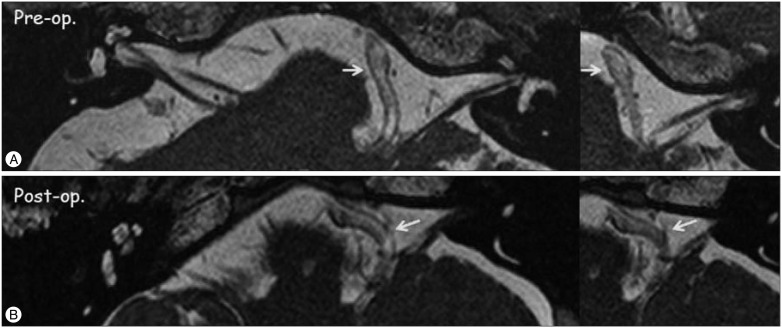J Korean Neurosurg Soc.
2016 Sep;59(5):505-511. 10.3340/jkns.2016.59.5.505.
Bioglue-Coated Teflon Sling Technique in Microvascular Decompression for Hemifacial Spasm Involving the Vertebral Artery
- Affiliations
-
- 1Department of Neurosurgery, Ajou University School of Medicine, Suwon, Korea. yhahn00@naver.com
- 2Department of Neurosurgery, School of Medicine, Konkuk University, Konkuk University Chungju Hospital, Chungju, Korea.
- 3Neuroscience Graduate Program, Department of Biomedical Sciences, Graduate School of Ajou University, Suwon, Korea.
- KMID: 2351720
- DOI: http://doi.org/10.3340/jkns.2016.59.5.505
Abstract
OBJECTIVE
Microvascular decompression (MVD) for hemifacial spasm (HFS) involving the vertebral artery (VA) can be technically challenging. We investigated the therapeutic effects of a bioglue-coated Teflon sling technique on the VA during MVD in 42 cases.
METHODS
A bioglue-coated Teflon sling was crafted by the surgeon and applied to patients in whom neurovascular compression was caused by the VA. The radiologic data, intra-operative findings with detailed introduction of the procedure, and the clinical outcomes of each patient were reviewed and analyzed.
RESULTS
The 42 patients included in the analysis consisted of 22 females and 20 males, with an average follow-up duration of 76 months (range 24-132 months). Intraoperative investigation revealed that an artery other than the VA was responsible for the neurovascular compression in all cases : posterior inferior cerebellar artery (PICA) in 23 patients (54.7%) and anterior inferior cerebellar artery (AICA) in 11 patients (26.2%). All patients became symptom-free after MVD. Neither recurrence nor postoperative neurological deficit was noted during the 2-year follow-up, except in one patient who developed permanent deafness. Cerebrospinal fluid (CSF) leak occurred in three patients, and one required dural repair.
CONCLUSION
Transposition of the VA using a bioglue-coated Teflon sling is a safe and effective surgical technique for HFS involving the VA. A future prospective study to compare clinical outcomes between groups with and without use of this novel technique is required.
MeSH Terms
Figure
Cited by 1 articles
-
Microvascular Decompression for Glossopharyngeal Neuralgia: Clinical Analyses of 30 Cases
Mi Kyung Kim, Jae Sung Park, Young Hwan Ahn
J Korean Neurosurg Soc. 2017;60(6):738-748. doi: 10.3340/jkns.2017.0506.010.
Reference
-
1. Attabib N, Kaufmann AM. Use of fenestrated aneurysm clips in microvascular decompression surgery. Technical note and case series. J Neurosurg. 2007; 106:929–931. PMID: 17542544.
Article2. Barker FG 2nd, Jannetta PJ, Bissonette DJ, Shields PT, Larkins MV, Jho HD. Microvascular decompression for hemifacial spasm. J Neurosurg. 1995; 82:201–210. PMID: 7815147.
Article3. Bejjani GK, Sekhar LN. Repositioning of the vertebral artery as treatment for neurovascular compression syndromes. Technical note. J Neurosurg. 1997; 86:728–732. PMID: 9120641.
Article4. Campos-Benitez M, Kaufmann AM. Neurovascular compression findings in hemifacial spasm. J Neurosurg. 2008; 109:416–420. PMID: 18759570.
Article5. Choi MS, Kim YI, Ahn YH. Lipoma causing glossopharyngeal neuralgia : a case report and review of literature. J Korean Neurosurg Soc. 2014; 56:149–151. PMID: 25328654.
Article6. Chung SS, Chang JH, Choi JY, Chang JW, Park YG. Microvascular decompression for hemifacial spasm : a long-term follow-up of 1,169 consecutive cases. Stereotact Funct Neurosurg. 2001; 77:190–193. PMID: 12428639.
Article7. Chung SS, Chang JW, Kim SH, Chang JH, Park YG, Kim DI. Microvascular decompression of the facial nerve for the treatment of hemifacial spasm : preoperative magnetic resonance imaging related to clinical outcomes. Acta Neurochir (Wien). 2000; 142:901–906. discussion 907. PMID: 11086829.8. Dannenbaum M, Lega BC, Suki D, Harper RL, Yoshor D. Microvascular decompression for hemifacial spasm : long-term results from 114 operations performed without neurophysiological monitoring. J Neurosurg. 2008; 109:410–415. PMID: 18759569.
Article9. Ehni G, Woltman HW. Hemifacial spasm : review of one hundred and six cases. Arch NeurPsych. 1945; 53:205–211.10. Ferreira M, Walcott BP, Nahed BV, Sekhar LN. Vertebral artery pexy for microvascular decompression of the facial nerve in the treatment of hemifacial spasm. J Neurosurg. 2011; 114:1800–1804. PMID: 21275561.
Article11. Huh R, Han IB, Moon JY, Chang JW, Chung SS. Microvascular decompression for hemifacial spasm : analyses of operative complications in 1582 consecutive patients. Surg Neurol. 2008; 69:153–157. PMID: 18261641.
Article12. Hyun SJ, Kong DS, Park K. Microvascular decompression for treating hemifacial spasm : lessons learned from a prospective study of 1,174 operations. Neurosurg Rev. 2010; 33:325–334. PMID: 20349099.
Article13. Ichikawa T, Agari T, Kurozumi K, Maruo T, Satoh T, Date I. "Double-stick tape" technique for transposition of an offending vessel in microvascular decompression : technical case report. Neurosurgery. 2011; 68(2 Suppl Operative):377–382. discussion 382. PMID: 21389896.14. Illingworth RD, Porter DG, Jakubowski J. Hemifacial spasm : a prospective long-term follow up of 83 cases treated by microvascular decompression at two neurosurgical centres in the United Kingdom. J Neurol Neurosurg Psychiatry. 1996; 60:72–77. PMID: 8558156.
Article15. Jannetta PJ, Abbasy M, Maroon JC, Ramos FM, Albin MS. Etiology and definitive microsurgical treatment of hemifacial spasm. Operative techniques and results in 47 patients. J Neurosurg. 1977; 47:321–328. PMID: 894338.16. Jo KW, Kong DS, Park K. Microvascular decompression for hemifacial spasm : long-term outcome and prognostic factors, with emphasis on delayed cure. Neurosurg Rev. 2013; 36:297–301. PMID: 22940822.
Article17. Kang JH, Kang DW, Chung SS, Chang JW. The effect of microvascular decompression for hemifacial spasm caused by vertebrobasilar dolichoectasia. J Korean Neurosurg Soc. 2012; 52:85–91. PMID: 23091664.
Article18. Khoo HM, Yoshimine T, Taki T. A "sling swing transposition" technique with pedicled dural flap for microvascular decompression in hemifacial spasm. Neurosurgery. 2012; 71(1 Suppl Operative):25–30. discussion 30-31. PMID: 22186845.
Article19. Kim JP, Park BJ, Choi SK, Rhee BA, Lim YJ. Microvascular decompression for hemifacial spasm associated with vertebrobasilar artery. J Korean Neurosurg Soc. 2008; 44:131–135. PMID: 19096662.
Article20. Kondo A. Follow-up results of microvascular decompression in trigeminal neuralgia and hemifacial spasm. Neurosurgery. 1997; 40:46–51. discussion 51-52. PMID: 8971823.
Article21. Kurokawa Y, Maeda Y, Toyooka T, Inaba K. Microvascular decompression for hemifacial spasm caused by the vertebral artery : a simple and effective transposition method using surgical glue. Surg Neurol. 2004; 61:398–403. PMID: 15031085.
Article22. Kwon HM, Lee YS. Dolichoectasia of the intracranial arteries. Curr Treat Options Cardiovasc Med. 2011; 13:261–267. PMID: 21404000.
Article23. Kyoshima K, Watanabe A, Toba Y, Nitta J, Muraoka S, Kobayashi S. Anchoring method for hemifacial spasm associated with vertebral artery : technical note. Neurosurgery. 1999; 45:1487–1491. PMID: 10598720.
Article24. Laws ER Jr, Kelly PJ, Sundt TM Jr. Clip-grafts in microvascular decompression of the posterior fossa. Technical note. J Neurosurg. 1986; 64:679–681. PMID: 3950754.25. Lee MH, Lee HS, Jee TK, Jo KI, Kong DS, Lee JA, et al. Cerebellar retraction and hearing loss after microvascular decompression for hemifacial spasm. Acta Neurochir (Wien). 2015; 157:337–343. PMID: 25514867.
Article26. Marneffe V, Polo G, Fischer C, Sindou M. [Microsurgical vascular decompression for hemifacial spasm. Follow-up over one year, clinical results and prognostic factors. Study of a series of 100 cases]. Neurochirurgie. 2003; 49:527–535. PMID: 14646818.27. Masuoka J, Matsushima T, Kawashima M, Nakahara Y, Funaki T, Mineta T. Stitched sling retraction technique for microvascular decompression : procedures and techniques based on an anatomical viewpoint. Neurosurg Rev. 2011; 34:373–379. discussion 379-380. PMID: 21347661.
Article28. McLaughlin MR, Jannetta PJ, Clyde BL, Subach BR, Comey CH, Resnick DK. Microvascular decompression of cranial nerves : lessons learned after 4400 operations. J Neurosurg. 1999; 90:1–8. PMID: 10413149.
Article29. Montaner J, Alvarez-Sabín J, Rovira A, Molina C, Grivé E, Codina A, et al. [Vertebrobasilar abnormalities in patients with hemifacial spasm : MR-angiography findings]. Rev Neurol. 1999; 29:700–703. PMID: 10560103.30. Park JS, Kong DS, Lee JA, Park K. [Hemifacial spasm : neurovascular compressive patterns and surgical significance]. Acta Neurochir (Wien). 2008; 150:235–241. discussion 241. PMID: 18297233.
Article31. Park KD, Kim YI, Ahn YH. Cerebello-pontine angle lipoma causing hemifacial spasm. J Korean Soc Stereotact Funct Neurosurg. 2014; 10:37–40.32. Payner TD, Tew JM Jr. Recurrence of hemifacial spasm after microvascular decompression. Neurosurgery. 1996; 38:686–690. discussion 690-691. PMID: 8692385.
Article33. Rawlinson JN, Coakham HB. The treatment of hemifacial spasm by sling retraction. Br J Neurosurg. 1988; 2:173–178. PMID: 3267301.
Article34. Samii M, Günther T, Iaconetta G, Muehling M, Vorkapic P, Samii A. Microvascular decompression to treat hemifacial spasm : long-term results for a consecutive series of 143 patients. Neurosurgery. 2002; 50:712–718. discussion 718-719. PMID: 11904020.35. Shigeno T, Kumai J, Endo M, Oya S, Hotta S. Snare technique of vascular transposition for microvascular decompression--technical note. Neurol Med Chir (Tokyo). 2002; 42:184–189. discussion 190. PMID: 12013673.36. Shimano H, Kondo A, Yasuda S, Inoue H, Park YT, Murao K. Microvascular decompression for hemifacial spasm associated with bilateral vertebral artery compression. World Neurosurg. 2015; 84:1178.e0005–1178.e0009. PMID: 26102619.
Article37. Sindou M, Leston JM, Decullier E, Chapuis F. Microvascular decompression for trigeminal neuralgia : the importance of a noncompressive technique--Kaplan-Meier analysis in a consecutive series of 330 patients. Neurosurgery. 2008; 63(4 Suppl 2):341–350. discussion 350-351. PMID: 18981841.38. Thirumala P, Frederickson AM, Balzer J, Crammond D, Habeych ME, Chang YF, et al. Reduction in high-frequency hearing loss following technical modifications to microvascular decompression for hemifacial spasm. J Neurosurg. 2015; 123:1059–1064. PMID: 26162037.
Article39. Tomasello F, Alafaci C, Salpietro FM, Longo M. Bulbar compression by an ectatic vertebral artery : a novel neurovascular construct relieved by microsurgical decompression. Neurosurgery. 2005; 56(1 Suppl):117–124. discussion 117-124. PMID: 15799799.40. Yuan Y, Wang Y, Zhang SX, Zhang L, Li R, Guo J. Microvascular decompression in patients with hemifacial spasm : report of 1200 cases. Chin Med J (Engl). 2005; 118:833–836. PMID: 15989764.
- Full Text Links
- Actions
-
Cited
- CITED
-
- Close
- Share
- Similar articles
-
- Pathological Changes of the Blood Vessel Wrapped in Teflon(polytetrafluoroethylene) Felt in the Cat
- Hemifacial Spasm Caused by Fusiform Aneurysm at Vertebral Artery-Posterior Inferior Cerebellar Artery Junction
- Microvascular triple decompression for combined simultaneous trigeminal neuralgia, hemifacial spasm, and pulsatile tinnitus due to separate offending vessels
- Hemifacial Spasm Developed after Contralateral Vertebral Artery Ligation
- Hemifacial spasm: the value of vertebral angiography




